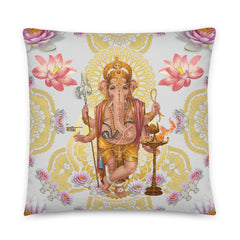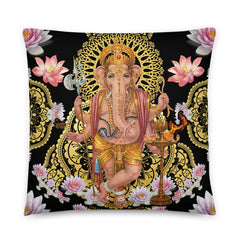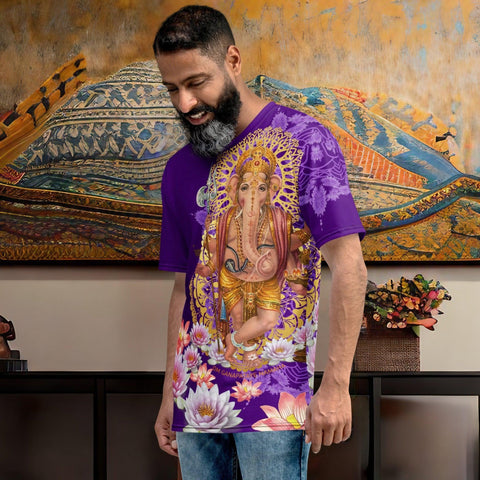Ganesh Meaning: Symbolic Meaning of the Elephant-Headed Hindu God Ganesh
Posted by Massimiliano Geraci

Finding meaning in our lives often feels like a journey filled with obstacles. Perhaps you're facing challenges or seeking wisdom to navigate your spiritual path even more smoothly. Interestingly, the elephant-headed Hindu god Ganesha symbolizes just that – the remover of obstacles and the bestower of intellect and good fortune.
This deity holds profound symbolism in Hindu mythology, embodying solutions and guidance for those who revere him.
Did you know that Ganesh's head was not always that of an elephant? A captivating story behind his unique appearance sheds light on themes of resilience, transformation, and rebirth—core aspects vital to overcoming life’s hurdles.
Our article delves into these symbolic meanings, exploring how Lord Ganesh can inspire success and clear the way forward in both spiritual practices and everyday life. Discover how this deity’s image brings positive energy into homes around the world.
Keep reading to explore these ancient truths for modern living.
What is the Symbolism of Ganesh in Hindu Mythology?
Moving from the introduction into the deeper layers of Ganesh's symbolism reveals a rich tapestry of meanings embedded within Hindu mythology. Ganesh, known as the remover of obstacles, serves as a symbol for beginning new ventures and overcoming challenges.
His large elephant head, a distinctive feature, symbolizes wisdom, understanding, and a discriminating intellect that can differentiate between truth and illusions. This unique attribute highlights his role as Lord of Ganas (troops), positioning him as an essential figure in handling life's hurdles.
Sri Ganesha carries various objects with profound symbolic value: his axe cuts attachments to material desires; the rope indicates control over thoughts; and his small mouth teaches the importance of listening more than speaking. These sacred symbols, including the broken left tusk and the lotus flower, reflect Vedic culture. His round belly represents the root chakra, or muladhara chakra, anchoring him to the earth. The mantra "om gam ganapataye namaha" invokes these iconographic elements, emphasizing Ganesha's role in grounding and spiritual wisdom.
One a broken tusk represents wisdom while being a broken tusk represents sacrificing parts of ourselves for higher goals. Furthermore, riding on a mouse illustrates Ganesh’s ability to control egoism and desire. Together these elements craft an intricate picture of balance, discernment, and enlightenment.
Ganesh stands not just at thresholds but also at crossroads in life's journey, guiding souls to understanding deeper universal truths.

Understanding Ganesh as the Remover of Obstacles
Ganesh, revered as the remover of obstacles, holds a cherished place in Hindu tradition. This elephant-headed god symbolizes the clearing of paths for believers' spiritual and worldly journeys.
Devotees often seek Ganesh's blessing at the beginning of new ventures to ensure smooth progress devoid of hindrances. His association with wisdom and intellect further empowers individuals to overcome challenges through enlightenment.
In rituals, Ganesh is invoked first among all deities, highlighting his significance in overcoming obstacles before any auspicious event. The act of worshiping Ganesh intertwines with the belief that acknowledging him can remove barriers that prevent success and harmony in one’s life.
With his broken tusk and large ears, he teaches us to retain good advice and discard unnecessary information, guiding adherents to achieving goals with greater clarity.
The Symbolic Meaning of Ganesh's Elephant Head
Moving from Ganesh's role as the remover of obstacles, we transition to a distinctive feature that significantly contributes to his symbolic value: the elephant head. This elephant head symbolizes wisdom, understanding, and a discriminating intellect that discerns between truth and ignorance.
The large ears suggest a great ability to listen and assimilate ideas; this is pivotal for spiritual growth and removing ignorance. The small eyes imply concentration and the ability to perceive subtle details, essential traits for achieving success in life.
The trunk represents adaptability and efficiency. In Hindu iconography, the trunk's dexterity—to hold both delicate offerings like flowers and remove massive obstacles—emphasizes Ganesh’s function in guiding devotees through life's varied challenges with grace.
Moreover, one of his tusks being broken off serves as a reminder of sacrifice and suggests that one must overcome dualities such as success-failure to attain perfection and true wisdom. Thus, every aspect of Ganesha's elephant head holds profound symbolic meanings related to knowledge, intelligence, patience, and listening—a constellation of qualities that aid individuals in maneuvering their spiritual journey effectively.

Representation of Lord Ganesh's Four Arms
Transitioning from the significance of Lord Ganesh's elephant head, the representation of his four arms holds profound symbolic value in Hinduism, each signifying core aspects of spiritual progress and worldly achievement.
In one hand, Ganesh often holds a pasha (noose), symbolizing attachment and our ability to conquer desires. Another arm bears an ankusha (elephant goad), representing control over the mind, guiding it to spiritual paths away from ignorance.
The third hand usually gestures mudras or carries sweets, embodying rewards of wisdom and the sweet results of pursuing knowledge. Lastly, His fourth hand may display a blessing gesture or hold objects like a rosary or book, indicating protection for devotees and enlightenment.
Ganesh's four arms guide us through life's obstacles to ultimate wisdom.
These elements collectively symbolize tools necessary for human salvation—emotional control through detachment (pasha), mental and spiritual discipline (ankusha), enjoyment of acquired wisdom (sweets), and spiritual guidance under Ganesh's blessing.
Through this powerful imagery, devotees are reminded that success is earned by overcoming personal barriers with divine help.
How Does Lord Ganesh Help You Succeed?
Lord Ganesh, revered as the remover of obstacles, plays a pivotal role in guiding individuals to success. His presence is believed to eliminate barriers that hinder progress, making way for new beginnings and prosperity.
As the deity associated with intellect and wisdom, Ganesh empowers followers to harness their mental faculties more effectively. This divine intervention enables one to overcome challenges with greater ease and make decisions that lead to achievement and fulfillment.
Engaging in Hindu rituals honoring Ganesh further attracts good fortune into one's life. The act of prayer or meditation focused on this powerful deity invokes positive energies, aligning spiritual forces to support personal endeavors.
Whether starting a new business venture or pursuing academic goals, invoking Ganesh’s blessings is seen as essential for ensuring success. His venerated status within Hinduism underscores his profound influence not only in removing physical obstacles but also those within the mind and spirit that impede one's path to success.
The Role of Ganesh in Bringing Good Fortune
Ganesh, revered as the remover of obstacles and the harbinger of good fortune, plays a pivotal role in Hindu traditions. His presence is sought at the beginning of any new venture or journey to ensure success and ward off potential setbacks.
The deity's connection to good fortune isn't just about material wealth; it extends to the spiritual aspect, where he guides individuals toward enlightenment and self-realization. This guidance comes from his attributes that symbolize intellect and wisdom, qualities necessary for overcoming life’s hurdles.
By invoking Ganesha's blessings through rituals and prayers, devotees believe they can ease their path through life's challenges. Ganesh's ability to remove obstacles is closely associated with his role in granting prosperity and success in various aspects of life including business endeavors, academic pursuits, and personal growth journeys.
The elephant-headed god stands as a testament to resilience and perseverance needed to manifest one’s desires into reality. Through statues placed in homes or temples dedicated in his honor, followers continuously seek Ganesh’s divine support for attracting positive energies and auspicious beginnings.
How Ganesh Represents Intellect and Wisdom
The elephant-headed Hindu god Ganesh symbolizes intellect and wisdom, reflecting his role as the principal deity of learning and the remover of obstacles. In Hindu mythology, this representation is deeply tied to his story and attributes.
For instance, the large head of Ganesh signifies broad thinking and understanding, encouraging devotees to think big and beyond the conventional constraints. The small eyes, conversely, represent focused concentration needed to achieve success in any endeavor.
This blend of broad vision with concentrated focus embodies the essence of intellectual pursuit and wisdom.
Ganesh’s association with education, knowledge-seeking endeavors, and literature further cements his symbolism for intellect. His portrayal holding a pen in one hand and scriptures in another serves as a reminder that continuous learning is key to overcoming life's hurdles and attaining enlightenment or 'moksha'.
It highlights how intelligence combined with learnedness leads to insightful decision-making processes—a fundamental aspect required to navigate through life's challenges successfully.
In every endeavor start by worshiping Ganesha for it is he who will remove obstacles from your path.
Ganesh in Hindu Rituals and Everyday Life
Ganesh holds a pivotal role in Hindu rituals and the everyday spiritual life of devotees, symbolizing the removal of obstacles for all new beginnings. Worship in Hinduism venerates him across various ceremonies, from the grandeur of Ganesh Chaturthi to daily prayers within households.
His image graces entrances, reflecting beliefs in his ability to protect and guide toward good fortune. In educational pursuits, students pray to him before exams, seeking wisdom and success.
Artisans craft statues of Ganesh with reverence, embedding symbolism into each piece—an act that channels devotion beyond mere physical forms. These sculptures find their place in homes and temples alike, serving as physical reminders of Hindu gods' omnipresence and the universal soul's connection with the divine.
Through festivals dedicated to him, communities come together, fostering unity and spirituality guided by principles laid out in texts like the Ganesha Purana and Vedas—demonstrating how deeply Ganesh is revered across aspects of life.
What is the Meaning Behind Ganesh's Appearance?
The unique appearance of the Hindu elephant god, Ganesh, is rich with ancient symbolism and carries deep spiritual meaning. His elephant head symbolizes atman or the soul, which is the ultimate reality of existence, standing in stark contrast to maya or illusion represented by his human body.
This teaches that real wisdom goes beyond appearances. The story behind Ganesh’s boy’s head being replaced with head of an elephant that's epitomizes resilience and transformation—a son of Lord Shiva and Parvati overcoming a dramatic challenge to embody wholeness and insight.
Holding various objects in his four arms, each item Ganesh carries has its own symbolic value. The axe he wields cuts away attachment the physical world, leading followers toward a path of enlightenment free from the material world's constraints.
Beside him often sits a small rat, Kroncha, symbolizing desire and its ability to gnaw through obstacles’ ties hindering spiritual progress. Together, these elements portray Ganesh as a deity overseeing success and as an embodiment of intellect, wisdom, and guidance for souls on their journey through samsara towards moksha or liberation from the cycle of rebirth.

The Story of Ganesh's Boy’s Head
Ganesh, also associated with the Sanskrit word for wisdom and removal of obstacles, is depicted with an elephant's head, a symbolic figure rich in meaning across Hinduism. Legend narrates that Parvati, desiring privacy while bathing, created Ganesha's form from clay to guard her door.
Shiva, unaware of this new being's creation and denied entry, decapitated Ganesh in anger. Hearing the commotion and understanding what had transpired devastated Parvati. She asked Lord Shiva, the supreme god to bring their son back to life.
Shiva then ordered his followers to return with the head of the first living creature they found facing north which happened to be an elephant. Employing his divine powers, Shiva attached the elephant’s head onto Ganesha’s body and breathed life into him once again. This act resurrected Ganesh and also symbolized the birth of a deity who would later become revered as a remover of obstacles (Vighnaharta), thus holding immense significance within Hindu mythology as well as in rituals performed for new beginnings and important events seeking blessings for success without hindrance.
Symbolism of the Axe Held by Ganesh
Transitioning from the remarkable story of how Ganesh received his elephant head, one cannot ignore the profound symbolism embodied in the axe he holds. This tool represents both the severance of all attachments to the material world and the cutting away of obstacles that hinder spiritual growth.
The axe, a striking symbol within Hindu iconography, is traditionally worshipped as not just an instrument of destruction but also a vehicle for creation through clearing impediments on the path to enlightenment.
The act of Ganesh wielding an axe goes beyond mere mythology; it serves as a metaphorical lesson for devotees to cultivate discernment and strength in overcoming personal challenges.
It teaches that one must be willing to detach from all worldly attachments, desires and misconceptions to achieve higher consciousness awareness. By holding this powerful weapon, Ganesh reminds us that breaking free from karmic cycles requires active engagement and courage, empowering individuals to forge their destiny with wisdom and clarity.
Why Ganesh is Often Depicted with a Rat
Ganesh is often depicted with a rat as his vahana or vehicle, a pairing that symbolizes the ability to overcome any obstacle. The rat, known for its keen ability to move through the narrowest of paths and darkest corners, represents Ganesh's power to remove physical, spiritual, or psychological barriers in one’s life.
This unique association also emphasizes Ganesh's role in controlling the symbol of ignorance and darkness since rats typically live in the dark.
Furthermore, this imagery connects deeply with the concept of ganapati upanishad where Ganesh stands as a guardian at the doorway to consciousness and enlightenment. By riding on a rat, Lord Ganesh demonstrates mastery over both formidable obstacles and subtle challenges that reside within us.
He encourages followers to seek light even when faced with difficulties akin to traversing through pitch darkness. This depiction enriches Hindu iconography and imparts profound lessons on overcoming limitations by cultivating wisdom and intellect.
What Are the Myths Associated with the Hindu Elephant-Headed God?
Several myths surround the Hindu deity Ganesh, each rich in symbolic meaning and spiritual teaching. One prominent story narrates how Ganesh came to have the head of an elephant. According to mythology, Parvati created Ganesh as her son while Shiva was away.
When Shiva returned, he was denied entry by Ganesh, who did not recognize him. In anger, Shiva decapitated the boy. Realizing his grave mistake, Shiva replaced Ganish's head with that of an elephant's to bring him back to life, symbolizing the integration of wisdom and strength.
Another legend involves Ganesh placing a bet with his brother Kartikeya on who could circumnavigate the universe first. While Kartikeya set out on a literal journey around the universe, Ganesh simply walked around his parents, Parvati and Shiva, stating they represented the entire universe for him.
This tale of ganesha highlights themes of intellect over physical might and illustrates why ganesh is associated with wisdom and prudence in overcoming obstacles. Through these stories and many others found within Hindu texts like Rigveda and Puranas, Lord Ganesha embodies profound philosophical teachings centered on devotion, intellectuality karma’s cycle offering insights into mastering life’s challenges.
The Ancient Symbolism of Ganesh
Ganesh, revered as one of the most important gods in Hinduism, embodies a rich tapestry of ancient symbolism deeply rooted in spiritual and cultural narratives. His elephant head, a striking symbol within the Hindu pantheon, represents wisdom, understanding, and a discriminating intellect necessary to overcome obstacles.
This unique feature was bestowed by his father Shiva after an intense series of events leading to Ganesh's decapitation and subsequent revival. The story illustrates profound themes such as rebirth, divine intervention, and the intricate relationship between power and knowledge.
His mount, the small but mighty rat often seen riding beneath Ganesh's feet or gazing up at him adoringly, serves as another layer of symbolic depth. The rat mirrors attributes such as obscurity (moving through dark spaces), fertility (rapid reproduction rate), adaptability (surviving in various environments), linking them to Earth's generative forces that represent abundance and the ability to pierce through difficulties with grace.
Together with Ganesh's image—which also incorporates tools like Pasha for capturing difficulties—aum—the primordial sound for cosmic creation—and Laddus signifying reward—this tableau invites devotees into meditation upon life’s vastness from material needs to spiritual liberation beyond Samsara’s cyclical nature.
Parvati and Shiva in the Mythology of Ganesh
Parvati, the consort of Shiva and a deity revered in her own right, desired companionship during Shiva's extended absences. Utilizing turmeric paste applied to her body in her rituals, she crafted Ganesh, imbuing him with life to serve as her loyal guardian.
This act underscores Parvati's profound ability to create and protect, central themes in Hindu mythology that resonate deeply with themes of maternal devotion and divine power.
Shiva, unaware of Ganesh’s creation upon his return to Kailash, encountered the boy guarding Parvatis private chambers. Mistaking him for an intruder due to his steadfast refusal to allow entry—an order from Parvati herself—Shiva decapitated Ganesh in the ensuing conflict.
The depth of Parvati's anguish moved Shiva to action; he commanded his followers (ganas) to bring back the head of the first living being they encountered. A sleeping elephant was found first, leading Shiva to place its head onto Ganesh’s body and restore his life.
This narrative highlights pivotal concepts such as dharma (duty/righteousness), karma (action/result), and rebirth within Hindu philosophy while also stressing the unity and balance within divine relationships.
Common Myths and Stories about Ganesh
Many myths surround Ganesh, revealing his importance in Hindu mythology and beyond. One popular story tells of how Ganesh was asked by Parvati to stand guard at her door while she bathed. Shiva, returning home and finding an unknown boy blocking his entry, beheaded him in anger.
Distraught upon discovering the boy was her son, Parvati demanded he be brought back to life. Shiva then commanded his followers to bring the boy's head out of the first sleeping being they found facing north.
They came across an elephant and used its head to revive Ganesh, symbolizing the beginning of a new individual soul merging with universal consciousness.
Stories also highlight Ganesh's wisdom and intelligence. In a famous tale about sibling rivalry between Ganesh and his brother Kartikeya, they were tasked with circling the world thrice.
While Kartikeya set off on his peacock mount to physically circumnavigate the globe, Ganesh simply walked around their parents, Parvati and Shiva, stating that for him they represented the entire universe (Parikrama).
His smart interpretation not only won him praise but also subtly taught that all creation revolves around divinity and parental respect—a core belief in Hindu dharma captured beautifully through this mythological origin mythological stories.
How Do Statues of Ganesh Reflect His Symbolic Meaning?
Statues of Ganesh display his symbolic meaning through intricate details that embody spiritual and cultural significance. Every aspect of these statues, from the number of arms to the items they hold, communicates aspects of wisdom, prosperity, and the removal of obstacles.
For instance, Ganesh's elephant head symbolises unmatched intellect and the ability to master challenges in front of us. His four arms hold objects like a pasha (noose) representing control over desires and an axe to cut ties with attachment, directing worshippers toward enlightenment and conscious awareness.
The presence of a mouse at Ganesh’s feet illustrates humility and the presiding deity who’s ability to address all forms of good fortune around his waist signifies encompassing success across various areas.
Moreover, statues often portray Ganesh with one hand raised in a gesture of blessing, signifying protection and guidance from above. Placed at home or in Hindu temples as central figures for devotion, these statues not only serve as focal points for prayers but also remind adherents of their moral journey towards self-improvement under Ganesh’s watchful eye.
Popular Forms of Ganesh Statues
Ganesh statues represent a rich tapestry of symbolism and devotion, reflecting centuries of cultural and spiritual heritage. These sculptures come in various forms that encapsulate Lord Ganesh's diverse attributes, each resonating with devotees across the globe.
1. Siddhi Vinayak form embodies Ganesh as the granter of wishes, often invoked by those seeking success in endeavors or facing significant life decisions. This popular aspect shows him with his trunk turned to his left hand, which holds a sweet modak, symbolizing the rewards of wise decisions and perseverance.
2. Vighnaharta, or the remover of obstacles, showcases Ganesh with his trunk pointing towards his right hand. Devotees consider this posture effective in warding off difficulties, making it a common choice for new beginnings like buying a home or starting a business.
3. The Dhyana Ganapati variation captures him in a meditation pose, symbolizing introspection and enlightenment. Seated comfortably, with one hand gesturing fearlessness and the other granting boons, this form appeals to those seeking inner peace and clarity.
4. Bala Ganapati delights followers with its depiction of Ganesh as a child, embodying innocence and joy. Grasping diverse fruits and sweets in his hands, this portrayal highlights life's simple pleasures and the importance of approaching challenges with a pure heart.
5. Bhakti Ganapati portrays him holding several spiritual items like a banana, mango, coconut, and bowl of sweets—all tokens representing the material universe offered back to God in devotion.
6. Ekadanta refers to the single-tusked form that signifies resolve and uniqueness; here Ganesh holds an axe to chop away ignorance and a modak to reward enlightenment.
7. The dancing god Ganesha depicts him in joyful expression while rhythmically moving to celestial music; this form is thought to reflect happiness, wealth, and wisdom.
8. Sankat Hara Ganapati is venerated for its power to dissolve complex problems; four arms hold spiritual implements while he rides atop his mouse mount – demonstrating mastery over desires that obstruct personal growth.
Each statue serves as an object of worship and a medium through which believers connect with divine qualities they wish to emulate—faithfulness (Bhakti), courage (Siddhi), wisdom (Vighnaharta), or joy (Bala). Through these varied depictions, Lord Ganesh continues to inspire millions around the world in their pursuit of spirituality and fulfillment.
Where to Place Ganesh Statues at Home for Best Results
Selecting the perfect spot for Ganesh statues at home bears immense significance, especially for those entwined with spirituality and who revere the historical Vedic religion. These placements are not just about aesthetics; they tap into the vibrations of space to invite wisdom, prosperity, and protection.
-
The entrance of your home serves as an ideal location for a Ganesh statue. This positioning ensures that Ganesh, also associated with removing barriers, guards your home against negativity and welcomes positive energies.
-
Northeast corner of the house is often recommended by Vastu Shastra, ancient India's science of architecture. Placing a Ganesh statue here brings good fortune and helps in maintaining a peaceful atmosphere.
-
Near the study or workspace within your home to enhance concentration and intellect. Since Ganesh represents wisdom, having his statue close can aid in overcoming challenges related to education or career.
-
In the prayer room facing east ensures that every morning sun rays greet Lord Ganesh first. This practice is believed to activate divine energies, assisting in spiritual growth.
-
Keeping a small Ganesh statue on the dashboard of your vehicle acts as a protective charm for travelers. It symbolizes his role in safeguarding devotees from difficulties encountered while journeying.
-
Garden areas can benefit from Ganesh's presence too, especially if you dedicate a small corner for meditation or yoga activities outdoors. His association with nature facilitates a serene ambiance for these practices.
7 . Placement near the entrance of your kitchen aids in blessing the food prepared and consumed within, aligning with Hindu beliefs regarding nourishment being both physical and spiritual sustenance.
Each chosen spot reflects an aspect of life where Lord Ganesh's blessings are sought after—be it protection, prosperity, wisdom, or clearing obstacles—making him an integral part of Hindu households around the world.

The Importance of Ganesh Statues in Hindu Temples
Ganesh statues in Hindu temples play a pivotal role in embodying the spiritual and religious ethos of devotees. These statues, often crafted with great attention to symbolic detail, serve not just as decor but as focal points for prayer and meditation.
They represent Ganesh's attributes as the remover of obstacles, associated with good fortune and success in new ventures. Worshipers believe that by paying homage to Ganesh, they receive his blessings for wisdom, prosperity, and the removal of barriers in both their spiritual journey and daily life.
The presence of Ganesh statues also reflects hindu culture where Ganesh holds significance across various forms such as Heramba (protector of the weak) and Ekadanta (the single-tusked one).
Placing these idols at temple entrances signifies inviting positive energies inside while keeping negative influences at bay. Devotees often start rituals or any auspicious activities by invoking Ganesh’s name, demonstrating his integral role within Hindu practice.
Through these sacred images, worshipers connect with divine powers, seeking guidance from Ganesh's essence captured within each intricately carved figure.




















